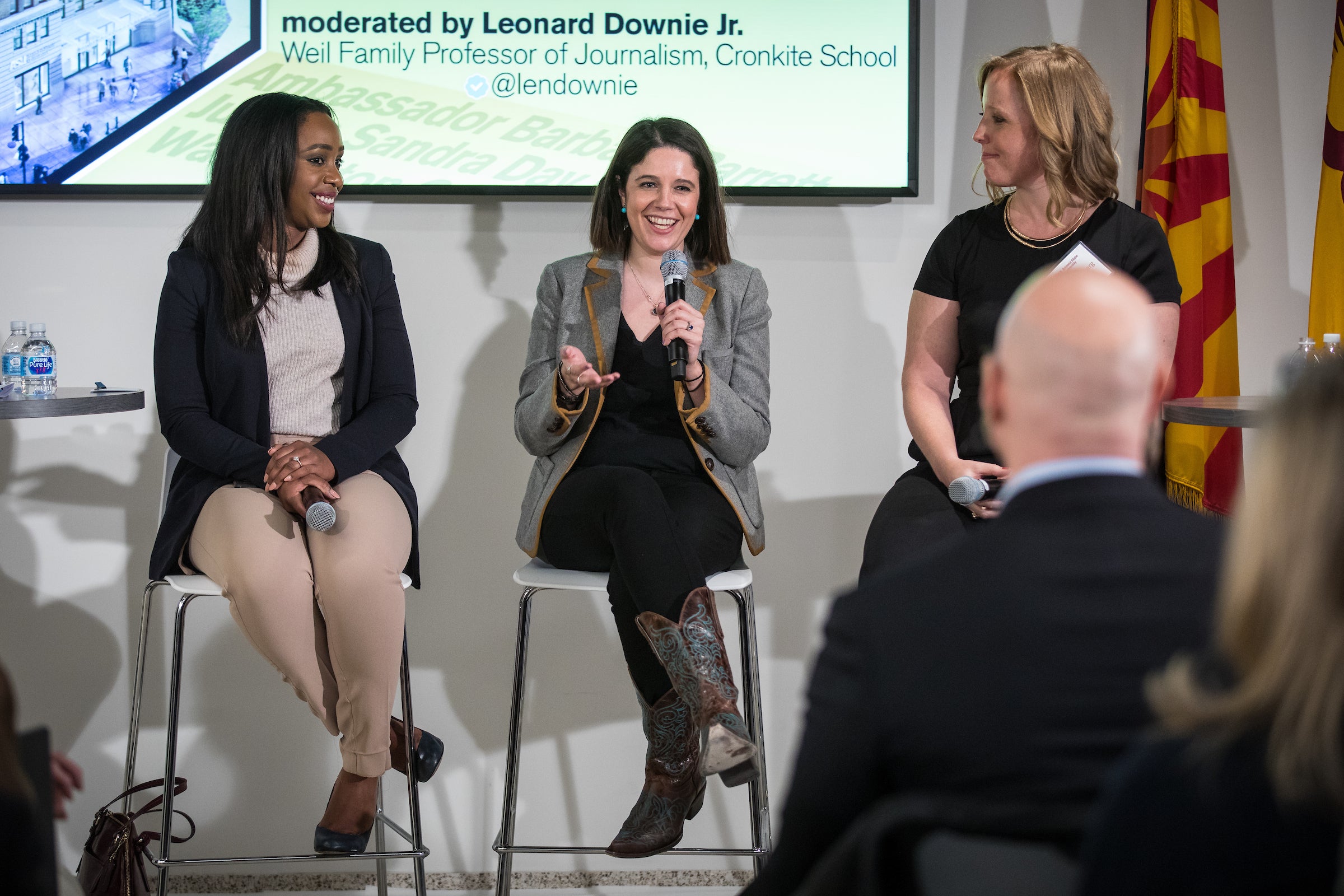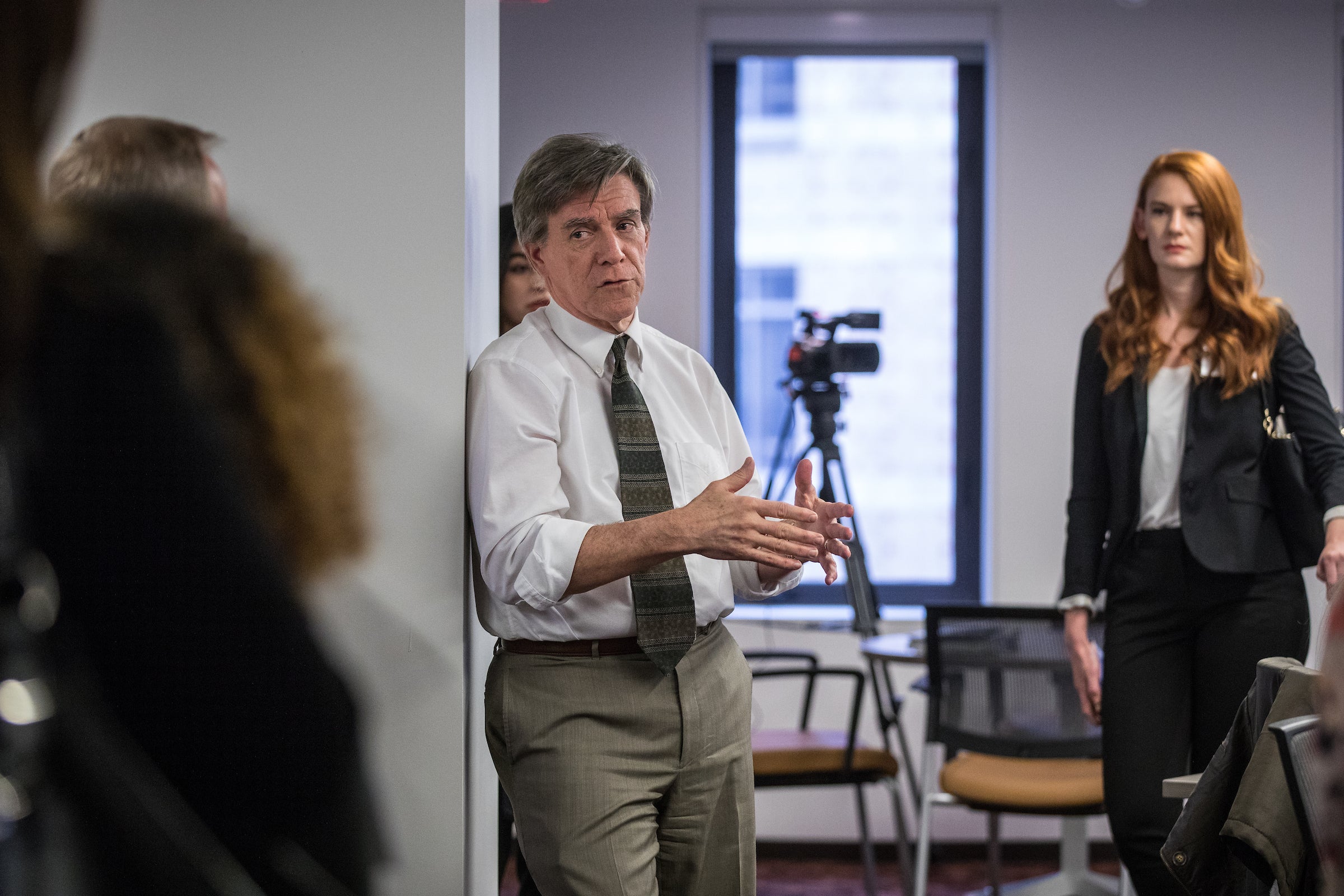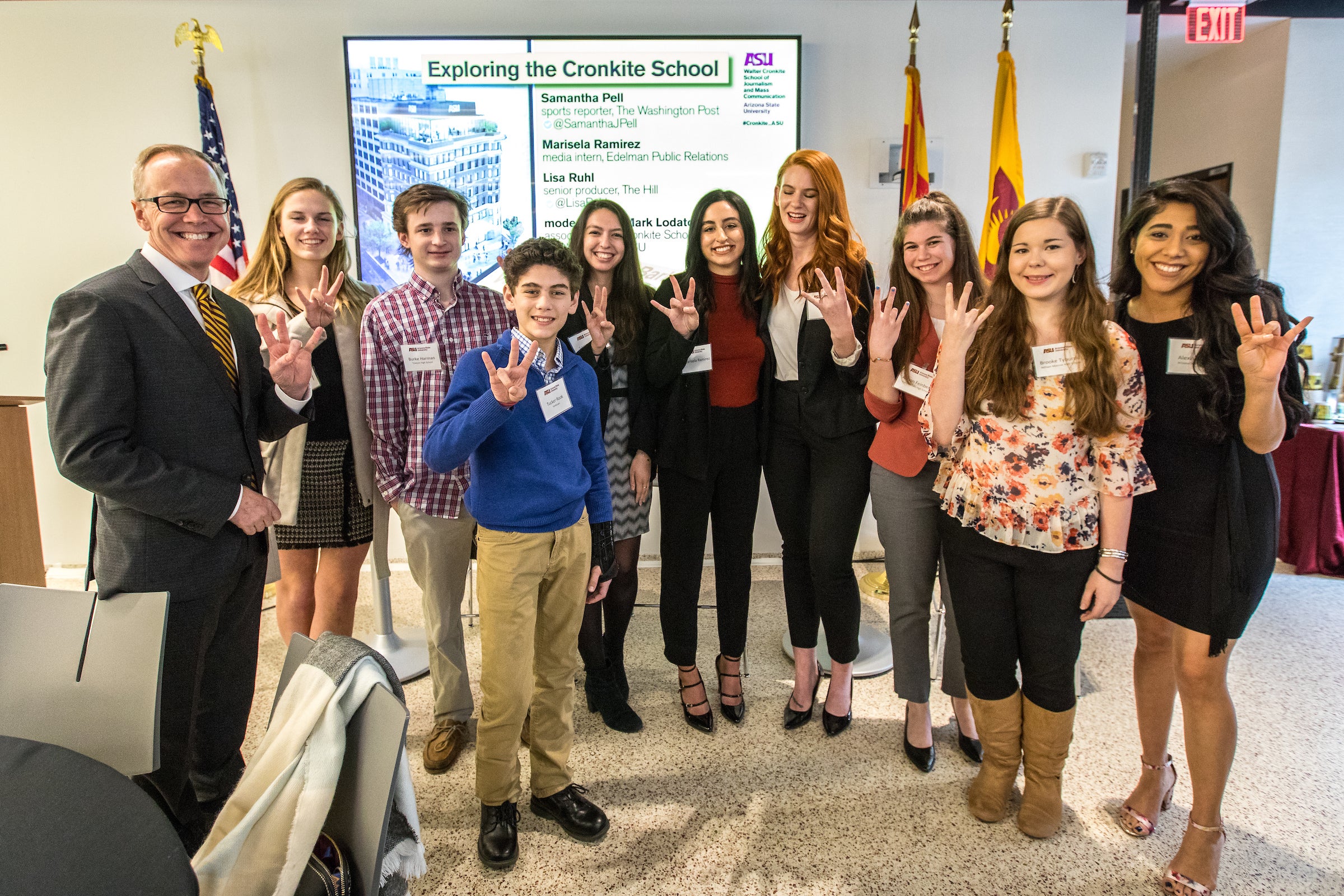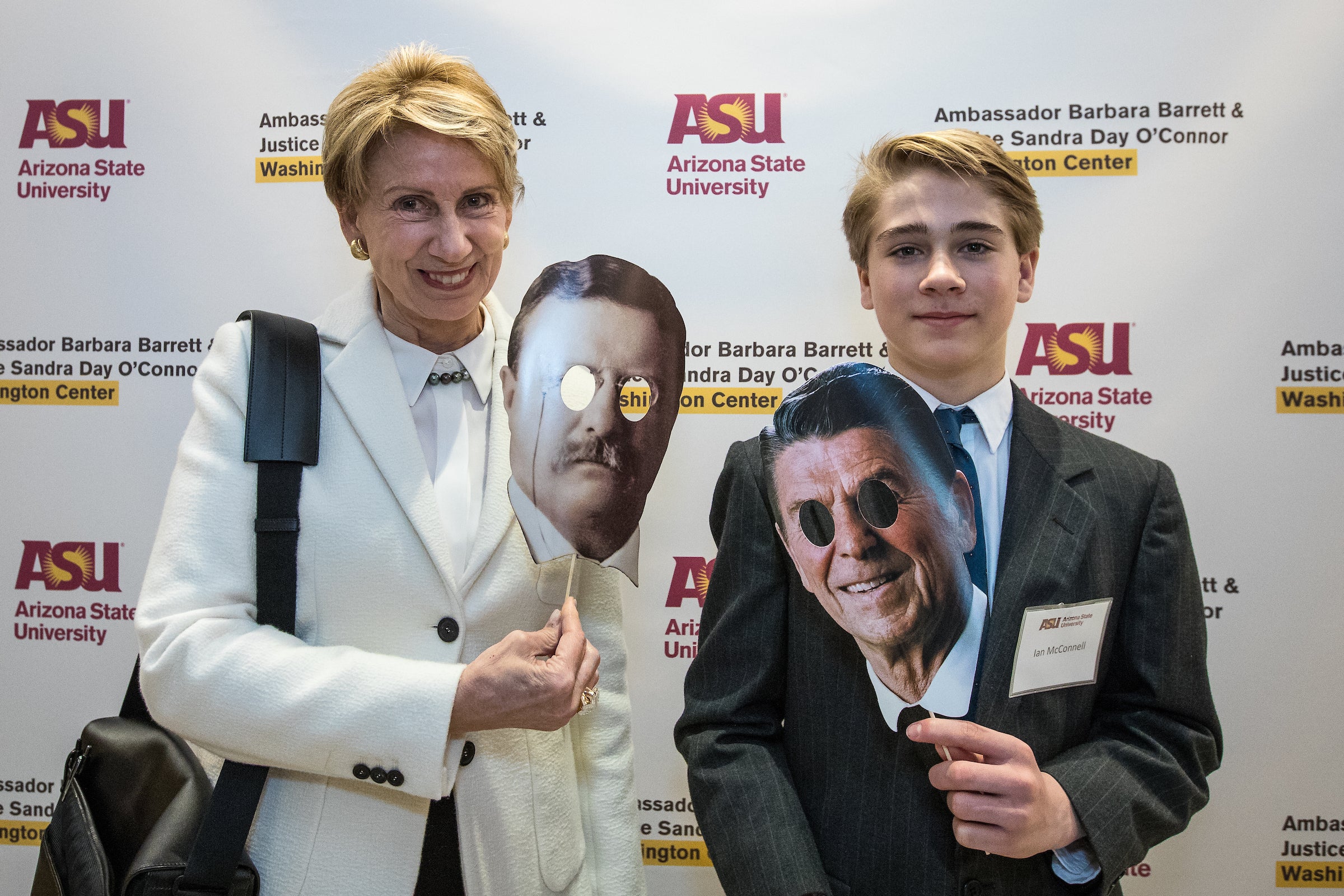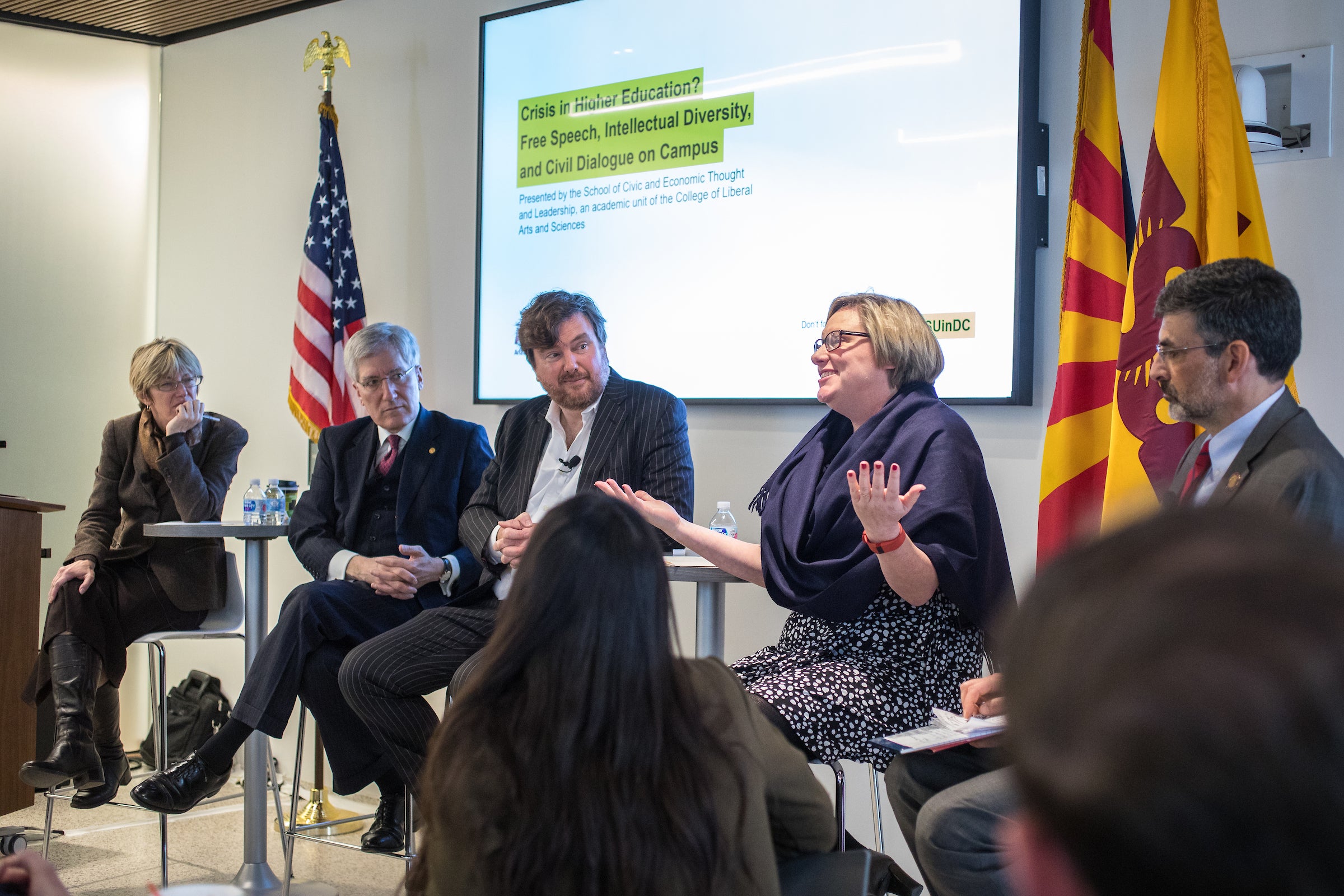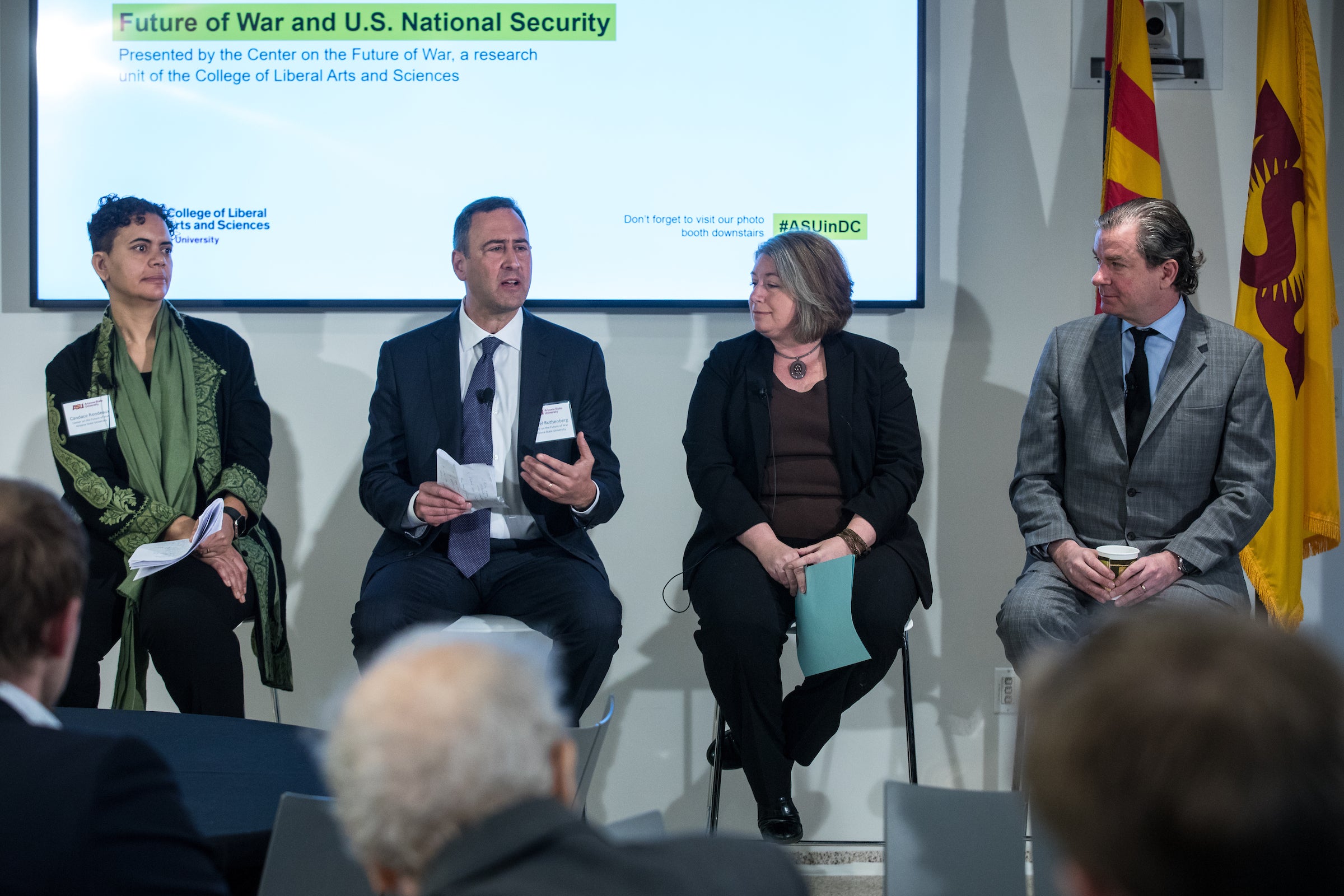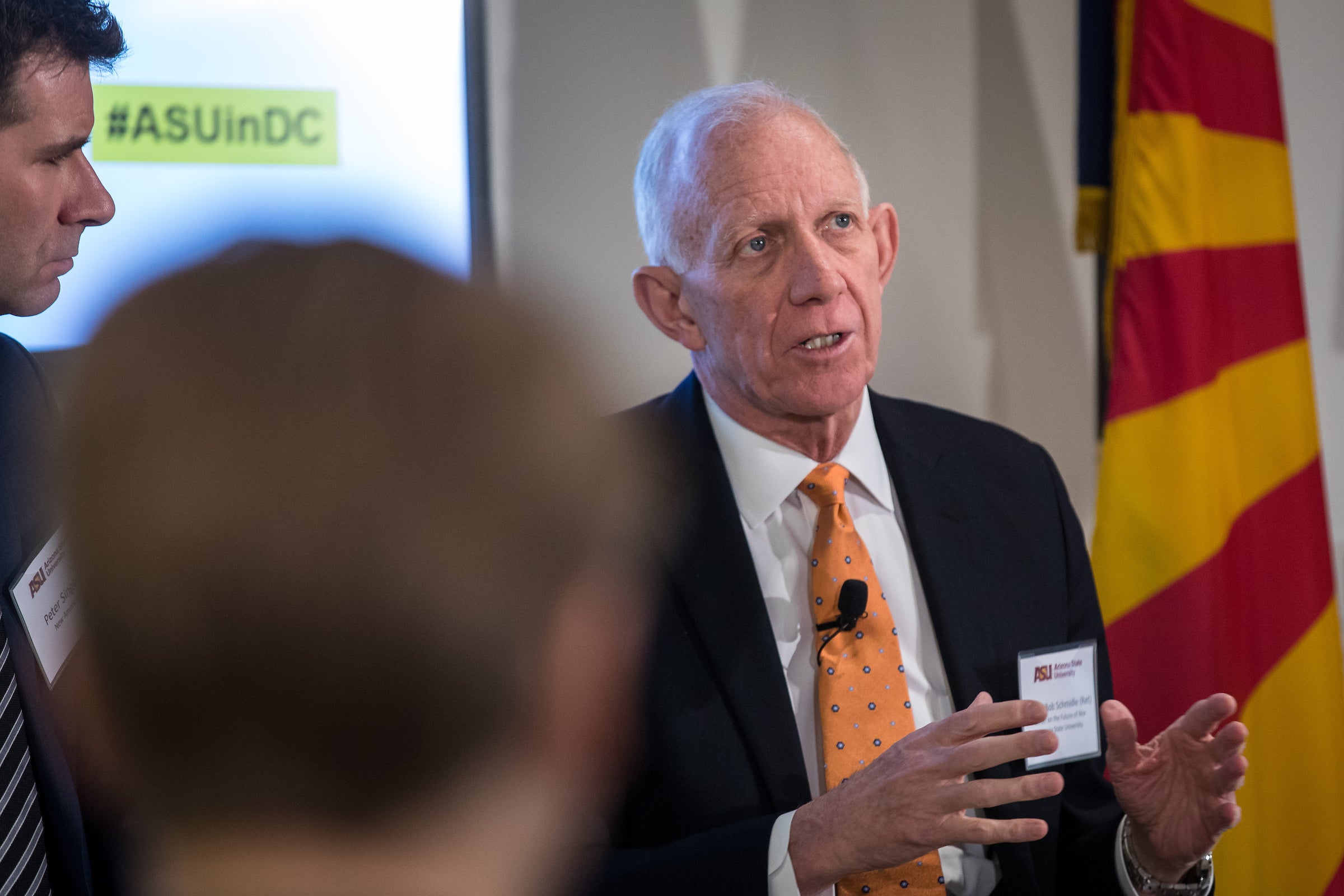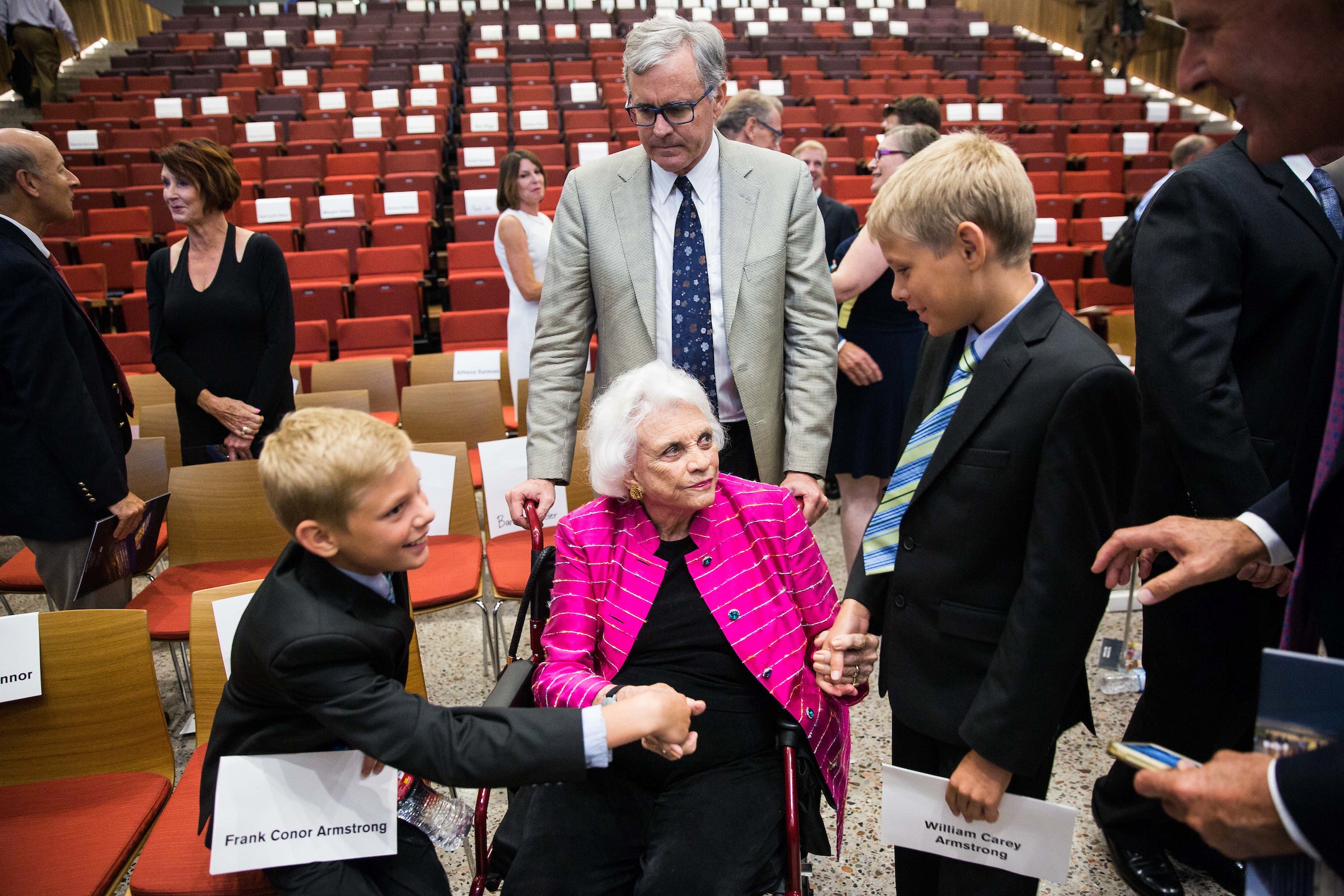Day 1: Free speech, national security and what it's like to cover Washington in the age of Trump

Editor's note: The first day of the opening week at the Ambassador Barbara Barrett & Justice Sandra Day O’Connor Washington Center at ASU was a full one. Here are the highlights; find the current day's blog here.
Panel: 'Covering Washington in the Age of Trump'
7:30 p.m. Monday, March 12
Washington Post White House reporter Ashley Parker (center) speaks to a full house, along with CNN White House correspondent Abby Phillip (left) and CBS This Morning senior producer Chloe Arensberg on the topic "Covering Washington in the Age of Trump" on Monday at the Barrett & O'Connor Washington Center. Photo by Charlie Leight/ASU Now
Three Washington journalists spoke about the changing media/political landscape in front of a standing-room-only audience Monday evening at the Barrett & O’Connor Washington Center.
Leonard Downie Jr.
Leonard Downie Jr., Weil Family Professor of Journalism at Cronkite (though he’s perhaps better known as the consultant on the film “The Post,” ASU Executive Vice President and University Provost Mark Searle quipped), moderated the event, throwing questions in front of the trio to get their take. Here’s a sampling.
Question: What’s different about covering this administration?
Abby Phillip, White House correspondent, CNN:
“Everything is different. … It’s probably as wild and chaotic as it seems to you (the news consumer), especially by comparison to past administrations.”
“…The White House can often be a very controlled environment. … (In this presidency) there are a lot of little tornadoes happening all over the federal government, and that’s what makes it so difficult to keep up as a reporter.”
Q: In a White House that seems to attack the press so much, why are there so many good sources?
Ashley Parker, White House reporter, Washington Post:
“This White House is in a lot of ways more accessible than previous White Houses. Some of this changed when John Kelly came in and implemented new discipline. … In the Obama White House, I remember, any little story I was doing they had to know what sorts of questions do you think you’ll be asking and what’s the topic and do you have an understanding of whether this will run on the front page or on A17. The Trump White House is not like that.
“You also have a lot more acute sense of what the president is thinking, because his tweets are literally what he’s thinking in the moment. I don’t buy the theory that he’s sort of strategically turning everyone’s attention away, covering up one chaotic thing with another.”
And as for all those sources? It’s because it’s often less compelling to be in front of him in person and more compelling to be in front of him “through the sheen of cable news.” So people are fighting it out in the press because it’s the most efficient way to sway the president.
Q: How do you handle all this chaos when preparing for news shows?
Chloe Arensberg, senior producer, CBS This Morning:
“Barely. <laughter from the audience> One of the most challenging things with a morning show is we have to have some kind of vague prediction of what might be driving the news at 7 a.m. in the morning. I work primarily day side the day before, and I have to say the number of times I’ve even woken up to seven different stories out of Washington that we had not originally had when I went to bed at 10, it’s astonishing.”
Q: Is some of this accessibility to sources in the White House part of the infighting there?
Phillip:
“The second layer of all of this starts with the fact that Trump is a candidate who came into politics fairly recently. So he has filled his White House with a lot of people who don’t know him that well, who haven’t worked for him particularly long. Some of whom are his family members, some of whom are longtime allies — although there are fewer and fewer of those people left — and what it creates are those factions you just mentioned.
“A lot of people with a lot of different interests working for this one person — that’s very different from what you typically get with a president. … Trump has always had the challenge of having a lot of people working with him who he frankly doesn’t trust a whole lot.”
Q: Are press briefings useful anymore? Do you still go to them?
Phillip:
“We do go to them. Are they useful? Some days I think they’re useful; some days I don’t. I think the greatest use — I think this is true not just of the Trump White House but of the Obama White House … the greatest use is to create a public record of what the White House’s position is on a given subject. I think it’s actually incredibly important.
“When everything distills and we find out what the real truth is, or we’re at the point where a decision needs to be made, we can compare that to what was said when we asked the question.
“… To the extent that we can press for answers on facts, I think it’s still very important. To the extent that it becomes this sort of game of trolling? Not so helpful.”
Arensberg:
Plus, “So much happens after the briefings now that they’re also often outdated and irrelevant in a matter of minutes after they conclude.”
Video by Jamie Ell/ASU Now
Q: Pro-Trump commentators often describe the press as part of the resistance to the president, trying to press him out of office. What’s your feeling on that — is it anti-Trump or normal accountability for the press to hold the president to?
Arensberg:
“I think it’s normal accountability. It’s an easy narrative to say we’re part of the resistance. I also think it dovetails nicely with the enemy-of-the-American-people, opposition-party rhetoric that this White House has attached to the news media. It depends on how tired you are, how you feel when you hear that language.
“But I do think technically we work in an environment with strong press freedom and a First Amendment, and things aren’t so bad.”
Q: Have you ever been the target of anti-media vitriol?
Parker:
(She covered him during the campaign, and Parker and New York Times colleague Maggie Haberman had just published a story that Trump did not like. Then they were at a big rally in San Diego.)
“All press, no matter what candidate I’ve covered, you’re always sort of enclosed by bike racks, but normally you’re in the back of the room. But with Trump we were part of the show. …
“We’re in the middle of this room of 10,000 people or more, and he starts complaining about our story. He says, ‘There’s a woman named Parker and a woman named Haberman, and they wrote the most’ — and I actually had a little name card that I quickly slid my laptop over — ‘they’re the most dishonest and the most despicable — they’re not here, are they?!’
“I’m sitting in the front row with a now slightly obscured name card, and the whole crowd turns around, ‘Boo hiss! Is Parker here?!’ and I was just like, <looks behind her> ‘Is she here?’
“The good part about being a print reporter is that no one knows who I am. A lot of my good friends who are on TV, especially women, felt a lot more vitriol. This has been reported, but CNN and other outlets got security guards for their female reporters to walk to their cars after rallies. So it was a slightly disconcerting, unnerving experience certainly for me to be called out in a negative way by (Trump) in a crowd of 10,000 people, but I knew my story was accurate — which was the main thing I cared about — and I also knew no one knew what I looked like.”
Phillip:
“I’ve had people post my parents’ address. I’ve had a conservative — I won’t even call this person a reporter — a conservative person who writes on a website online publish a story about my mother, including posting her photo online, in an attempt to attack me for coverage of a Trump surrogate. That kind of thing has really escalated.
“I don’t mind it personally … I worry more about the impact on your family and people who didn’t sign up for this. I signed up for this; my mother did not.”
Watch the full talk here, including the journalists’ views on when Ivanka Trump and Jared Kushner will leave the White House, what mistakes the media have made, people who have been vilified in public but whom they find quite sympathetic in person. ASU President Michael Crow also addressed the crowd at the end of the event, speaking about ASU's mission.
Video: Cronkite grads and jobs
Lisa Ruhl, senior producer at The Hill and one of the panelists in the afternoon Cronkite School event, graduated from ASU's master’s program in May 2011. She moved to Washington and reached out to Steve Crane, director of Cronkite's Washington Bureau, and the rest is history. Here she talks about that and how she pays it forward when she needs to fill a position at work — including her latest hire, fellow panelist Marisela Ramirez (Class of 2017).
Video by Jamie Ell/ASU Now
Tour: Cronkite School's Washington Bureau
5:45 p.m. Monday, March 12
In the afternoon, prospective students got to hear from alumni of the Cronkite School of Journalism and Mass Communication about what drew them to ASU, what they gained from the Cronkite School and the twists and turns in their careers.
The crowd then went down to the Barrett & O’Connor Washington Center’s fourth floor to tour the Washington Bureau newsroom, where Cronkite students work 15-week (12-ish weeks in summer) assignments covering the nation’s capital for Cronkite News/Arizona PBS.
Cronkite News/AZ PBS Washington Bureau director Steve Crane talks with nearly a dozen East Coast prospective journalism students as they tour the bureau and learn more about the opportunities at the Walter Cronkite School of Journalism and Mass Communication Monday in Washington, D.C. Photo by Charlie Leight/ASU Now
“You’re not a student reporter; you’re a reporter,” Steve Crane, director of the Washington Bureau, tells each new program cohort. The students get credentials by the Congressional press gallery, the same as other media.
“One of the great things about working in Washington — and I stole this from the dean — it's a line some reporters don't get on their resumes during their careers,” he continued.
Later, he spoke with ASU Now about the Washington program. It has hosted 138 students since starting in summer 2011 and runs every semester (fall, spring, summer). The students work with Crane and Bill McKnight and will be working next to Leonard Downie Jr.
Since the program began, its journalists have gone to four national political conventions, two inaugurations, six or seven States of the Union, and they have covered many Supreme Court cases and churned out thousands of news stories — “and we eat a lot of jelly beans,” Crane said.
Cronkite School Associate Dean Mark Lodato (left) and East Coast prospective journalism students (some younger than others) and alumni flash the ASU pitchfork in the Washington Bureau on Monday. Photo by Charlie Leight/ASU Now
Video: Why foreign policy is definitely worth it
3:05 p.m. Monday, March 12
Sharon Burke, one of the panelists from the national-security discussion this morning, talks about the views that gained voice after the last presidential election — that our global diplomacy wasn't worth the cost and time — and how that couldn't be more wrong.
CLAS overview — and civil disagreement among the D.C. crowd
2:49 p.m. Monday, March 12
Members of ASU's College of Liberal Arts and Sciences presented during lunch, sharing the accomplishments and range of the college and this video:
Afterward, they opened the room to questions about the previous panel.
Stanlie James, vice provost for inclusion and community engagement at ASU, had stopped by the new center while in Washington for the American Council on Education conference. She objected to several of the statements made during the "Crisis in Higher Education" panel, including statements about quelling emotion.
“I would argue if you’re a professor, you need to have passion,” she said.
Panelist Allison Stanger, who was still in the room watching the CLAS presentation, spoke up to clarify what she had said earlier. She spoke about being seriously injured by Middlebury protesters. Stanger said she saw how the passion of a small minority got others stirred up to actions they might not have otherwise, actions that those students later were surprised that they found themselves doing.
“There is a lot to be angry about what’s going on in this country. … Somehow as educators we have to validate those emotions” but in a way that moves the needle, Stanger said. Part of it is teaching people to harness their emotions to bring about the change they want to see, she said.
James thanked her for the clarification, and both expressed appreciation for the discussion.
FB Live: 'Covering Washington in the Age of Trump'
2:35 p.m. Monday, March 12
The panel "Covering Washington in the Age of Trump" will be livestreamed on ASU's Facebook page at 6 p.m. Eastern Daylight Time.
Video: A war by any other name ...
2:25 p.m. Monday, March 12
After this morning's panel on National Security, Lt. Gen. Robert Schmidle (ret.) spoke with the ASU Now crew about what happens when we use the word "war" to describe something that traditionally hasn't been considered a war.
Photo-booth fun
2:20 p.m. Monday, March 12
If you're at the Barrett & O'Connor Washington Center this week, don't forget to visit the photo booth in the lobby (and if you're posting on social, use #ASUinDC). See you there!
Ambassador Barbara Barrett poses with her nephew Ian McConnell, 15, of Blairsville, Pennsylvania, in the photo booth of the new Barrett & O'Connor Washington Center on Monday in Washington, D.C. The photo booth will be available all week during the grand opening. (And yes, there are Sparky masks too.) Photo by Charlie Leight/ASU Now
Video: Understanding the lived experience for people who aren't like you
Laura Beth Nielsen, one of the panelists from the earlier talk on the crisis in higher education, talks about why it's important to understand how ordinary people live and to communicate that across the political divide.
Video by Jamie Ell/ASU Now
Panel: Group discussion at 'Crisis in Higher Education'
1:20 p.m. Monday, March 12
Paul Carrese, founding director and professor at the School of Civic and Economic Thought and Leadership (SCETL) at ASU, introduced the panel at "Crisis in Higher Education? Free Speech, Intellectual Diversity, and Civil Dialogue on Campus." He explained how SCETL is dedicated to reviving the link between civic education and classic liberal education, and that the spirit of Socratic debate is crucial at both campus events and in the classroom.
Laura Beth Nielsen (second from right) speaks at the School of Civil and Economic Thought and Leadership panel discussion on the topic of "Crisis in Higher Education? Free Speech, Intellectual Diversity, and Civic Dialogue on Campus" Monday at the Barrett & O'Connor Washington Center. Looking on are (from left) Allison Stanger, Robert P. George, Greg Lukianoff and SCETL founding director Paul Carrese. Photo by Charlie Leight/ASU Now
Greg Lukianoff, president and CEO of the Foundation for Individual Rights in Education (FIRE), spoke about the six trends that he sees as stifling free speech in higher education: political correctness run amok, administration run amok (such as tiny free-speech zones, or speech codes that outlaw harsh text messages or email, or "inappropriate directed laughter"); feds run amok, professors run amok, students run amok and the right run amok.
“I get really tired of people saying, ‘Is it the right or left?!’ Can you just focus on the issues?” he said.
Later in the panel, he would say, “We have to have really high tolerance for difference of opinion; we must have zero tolerance for violence.”
Laura Beth Nielsen, professor of sociology and director of the Center for Legal Studies at Northwestern University and research professor at the American Bar Foundation:
“We need to consider and innovate how to best expose our students to new ideas,” she said. And to do that, we must do the hardest thing about free speech: We must listen.
She spoke about microaggressions and sexual speech.
“We have an inequality in the First Amendment right now,” she said. College women are told they have to put up with a fraternity crowd chanting “No means yes” because of free-speech rights.
“At the same time, we see a regime of free speech that protects the popular and the powerful,” Nielsen said, such as bans on panhandling, protecting workers, tourists and consumers. The Westboro Baptist Church protests ultimately inspired the congressional override that prohibits protests around soldiers’ funerals, but nothing mentioned about LGBTQ funerals, Nielsen said.
We expect white women, people of color and members of the LGBTQ community to uphold the right of others to speak, but businesses and others are protected, Nielsen said.
“Some decry the current generation as whiny, snowflakes — but I would argue the opposite,” she said. These students are demanding that their subordination experiences are heard.
What we must do “is try to help those who are not like us understand what the world is like for people like us … instead we seem to be in a shouting match over who is (censoring) whom and we skip right over the listening part of free speech.”
Robert P. George, McCormick Professor of Jurisprudence and director of the James Madison Program in American Ideals and Institutions at Princeton University:
“People are shut down on campus today — they’re shut down on the content of their speech” — not the aggressiveness of it, but the ideas of the content, George said. “Beyond the pale, worthy of being shut down and excluded, and even the basis for punishment.”
Campuses skew largely liberal, so students are hearing mainly one message.
“We’re not giving our students …. an education because they’re not hearing the engagement of competing viewpoints,” he said.
Though he may not agree with Nielsen on many points, he does agree on one: Listening is key, and few are doing it.
“No one is regarding each other as reasonable people of goodwill who happen to disagree on certain issues,” George said.
Incivility is reflected in and provoked by the people brought on campus deliberately to be provocateurs, George said. He thinks that’s largely the “sense of suffociation” that students with dissenting views on campus feel, that they can’t express dissent or even have alternative viewpoints considered. So these people come in and “provide a service in causing an uproar” — and they do so in an incendiary way.
“There are many avenues to intellectual diversity and freedom of speech. And those advantages have mainly to do with allowing a university … to fulfill its mission,” George said That mission is three-part: seeking knowledge of truth, transmitting knowledge of truth once it’s obtained (and everything we believe on a campus should be open to challenge), and preservation of knowledge.
He said the best experience he has had in more than 30 years of teaching are the times he has teaching with Cornel West — working, teaching "and disagreeing, civilly and thoughtfully, but really disagreeing. And letting the students see that." That’s why having viewpoint diversity among the “grown-ups” is so key, he said. And as a result, the professors are better able to represent the other viewpoint more sympathetically.
RELATED: 2 professors, political opposites, urge concept of 'civic friendship'
Allison Stanger, Russell J. Leng ’60 Professor of International Politics and Economics, Middlebury College:
“I don’t think we have a First Amendment crisis. … I think what we’re really having is a debate over the purpose of higher education.”
Setting the ground rules for free expression is how colleges will get greater diversity, “without quotas or mandates from on high.” And also a problem are those who are rejecting ideas without even examining them.
“Group think, people mindlessly repeating what other people say … is the antithesis of liberal education,” Stanger said.
When you stop listening to other viewpoints, it is far easier to treat fellow human beings as a means to an end, rather than as humans, she said.
She also emphasized the importance of free thinking in a big-data world, her latest area of research. “There are companies that want to reduce people to algorithms,” she said — don't let them. It's the same reason she rejects the bell curve in favor of focusing on the individual.
Universities should be teaching students to harness emotion in service of truth seeking, Stanger said — to better resist fight-fire-with-fire tactics.
“Extremism has no place in liberal education.”
Video by Jamie Ell/ASU Now
FB Live: 'Crisis in Higher Education?'
10:38 a.m. Monday, March 12
The second panel, "Crisis in Higher Education? Free Speech, Intellectual Diversity, and Civil Dialogue on Campus" will be livestreamed on ASU's Facebook page at 11:30 a.m. Eastern Daylight Time.
Panel: Group discussion at 'Future of War and U.S. National Security'
10 a.m. Monday, March 12
(From left) Candace Rondeaux, Daniel Rothenberg, Sharon Burke and Peter Bergen take part in the Center on the Future of War panel discussion on U.S. national security during the launch of the new Barrett & O'Connor Washington Center on Monday. Photo by Charlie Leight/ASU Now
Peter Bergen, co-director of the Center on the Future of War and professor of practice at the School of Politics and Global Studies:
“We had an interesting choice on the morning of 9/11 to describe what happened,” he said. What if only 17 people had died? That's what happened a year before, and we didn't respond in the same way and with the same language. “How we describe things helps determine how we react to them.” We called 9/11 an act of war. “I don’t think we still have the language to describe what happened.”
Candace Rondeaux, senior fellow at the Center on the Future of War and professor of practice at the School of Politics and Global Studies, spoke on the strategic pillars and tactical issues in today's Afghanistan.
“If you look today at Afghanistan, the stories that we’ve been telling ourselves have been largely defined by the violence over the past 17 years. ... How did we get here? That’s the big question. We often focus so much on the violence itself … but we forget the political piece.”
We must redefine what winning there means.
“If the U.S. can take itself out of this battlefield focus and reassert a focus on politics, there’s a good chance things could stabilize,” Rondeaux said.
Daniel Rothenberg, co-director of the Center on the Future of War and professor of practice at the School of Politics and Global Studies, talked about fake news, alt facts and echo chambers. Even if this issue doesn’t seem like it plays off the future of war, he said, it does — it's at the heart of the discussion.
He talked about research reviewing Twitter feeds. The findings: “Falsehood consistently dominates truth.” Those tweets that present things that aren’t true get much more engagement — why? “These sort of stories are more novel and more interesting. Fake news is compelling and draws you in. ... These are emotionally evocative claims.”
We are over-invested in the divide between what is true and what is false, Rothenberg said. “One way to overcome that is to think about narratives.” People come up with stories to explain their circumstances. We need not outrage and hysteria but an attitude really tuned toward understanding the motivation behind fake news, he said.
Sharon Burke, senior adviser of the International Security Program and Resource Security Program at New America, quoted Voltaire as saying that air, earth and water are “arenas of destruction, in the natural state of perpetual war.”
True, Burke said, but they are also the drivers of war — and the elements that help nations recover from war.
Our demand on resources is growing. “Humans are remarkably ingenious” and we find new ways of finding what we need, she said, but everything involves tradeoffs.
There's room to improve on dealing with and distributing resources. The U.S. is the world's leading energy producer, which no one would have guessed 15 years ago (despite what some people claim now, she said). China produces almost all of world’s rare-earth elements, key to technology — “They own the resources of the future.” That will make pressure on resources more severe, or more unpredictable. And climate change will interact with resources, poverty and other issues that affect war in upexpected ways.
That has led to a new project at New America with ASU — “Phase Zero” (referring to Pentagon jargon about the phase before a war begins, when there's still time to make changes to head off war). They're looking at where the U.S. can make investments to promote resilience.
Barbara Barrett welcomes crowd
9 a.m. Monday, March 12
Ambassador Barbara Barrett welcomed the crowd at the "Future of War" panel Monday morning.
“This certainly is a timely matter, when we think about what’s going on globally, even just this week. ... We know have to think about beyond geography and beyond the global world into what’s going on cybersecurity,” she said.
She said she hopes this building and this partnershp will advance the work for more security — a future where “security is what we have and war is what we avoid.”
Ambassador Barbara Barrett and her husband, Craig Barrett, give their nephew Ian McConnell, 15, of Blairsville, Pennsylvania, a tour on the roof of the new Barrett & O'Connor Washington Center on Monday. Photo by Charlie Leight/ASU Now
Panel: Schmidle at 'Future of War and U.S. National Security'
8:45 a.m. Monday, March 12
Lt. Gen. Bob Schmidle (ret.) speaks during the first panel discussion on the Future of War and U.S. National Security at the launch of the new Barrett & O'Connor Washington Center on Monday morning in Washington, D.C. Photo by Charlie Leight/ASU Now
At the "Future of War and U.S. National Security," Lt. Gen. Bob Schmidle (ret.) said we often focus on the nature and character of war.
“But we ought to think about what is the essence of warfare," said Schmidle, a senior fellow in the Center on the Future of War, professor of practice in the School of Politics and Global Studies, and university adviser on cyber capabilities and conflict studies. "The essence of warfare in my mind is understanding what it is that holds sway over us in warfare. How does war administer violence? … How does a war develop? How does war decay?”
When using "war" in our language, he said: “We tend to think of periods of war and periods of peace. Peace are the interruptions where we hold our breath between periods of war.” But what if we think about war as just increases in the level of violence?
Peter Singer, senior strategist at New America, asked him whether we are organized for the future — do we "have the right people in the right boxes"? Schmidle said he didn't know, but that the game has changed from conventional setups. In the world of cybersecurity, everyone of us touches things. When you log onto your computer and open a link, you could infect the entire system.
“One of the challenges we’ve had with how we organized the system is that we’ve pushed the risk to the end user — and the end users are us, and we know we are the ones who make the most mistakes.”
On autonomous weapons: Imagine if an automated system determines a terror target is in a certain vehicle and destroys that vehicle, but a mistake is made and the wrong vehicle was hit.
“Who is it that owns that now? Who owns that risk and who owns that ethical decision?” Schmidle said. In the past, there was a commander who made the decision that that’s the vehicle and orders the strike. "But if we’re letting weapons do that on their own, is it the person who wrote the algorithms?"
As weapons become more autonomous, increased responsibility falls to policymakers, Schmidle said. It raises a lot of ethical and tactical issues.
“That’s one of the things about autonomous weapons that makes us most uncomfortable. We like to think that if there’s a decision to kill a person, that decision will be made by another human.”
Schmidle was asked what he thought of the president's and nation's current budget priorities and direction.
“Let’s see if I can make it through this without making the front page of the Washington Post,” he quipped.
The thing with budgets and innovation, he said, is that "the more money you have, the less incentive you have to innovate." But we must keep doing the research that might not result in anything tangible anytime soon, he said; "One of the hardest things to get money for is where scientists are looking at interesting things."
Good morning from ASU in DC
8 a.m. Monday, March 12
Photo by Charlie Leight/ASU Now
FB Live: 'Future of War and U.S. National Security'
7:46 a.m. Monday, March 12
The first panel, "Future of War and U.S. National Security," will be livestreamed on ASU's Facebook page at 8 a.m. Eastern Daylight Time.
Center namesakes: A primer on two ranchers
7:35 a.m. Monday, March 12
The Barrett & O’Connor Washington Center is named after two groundbreaking Arizona women. Sandra Day O’Connor made history in 1981 as the first woman to serve on the U.S. Supreme Court. Barbara Barrett, a three-time ASU graduate, was the first female Republican candidate for governor in Arizona and is the former U.S. ambassador to Finland. The center’s renovation was funded in part by a Campaign ASU 2020 gift from Barrett and her husband, Craig Barrett.
Learn more about these two outstanding women:
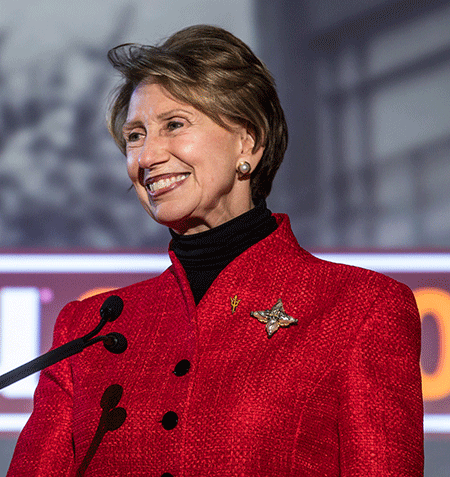
Barbara Barrett, three-time ASU graduate and former U.S. ambassador to Finland, speaks at the kickoff the final drive of Campaign ASU 2020 on Jan. 26, 2017, at Chase Field in Phoenix. Photo by Charlie Leight/ASU Now
When Barbara Barrett was the U.S. ambassador to Finland in 2008, she rode her bicycle more than 550 miles to get to know the country, visiting dozens of Finnish towns and forming friendships among the appreciative Finns. Soon after, at the invitation of the Russians, she spent seven months training 12 hours a day outside Moscow as the back-up astronaut on a Soyuz flight to the International Space Station.
Barrett, then 59 and an instrument-rated pilot, ended up watching another trainee rocket to space, but that may be one of the few life experiences she has missed: A lawyer, banker, adviser to four American presidents on trade and defense issues, former president of the American Management Association, former candidate for governor of Arizona, former deputy head of the Federal Aviation Administration, former interim president of Thunderbird School of Global Management, 2013 appointee to the Smithsonian Board of Regents and trustee to the board of the Jet Propulsion Laboratory, Barrett was the first civilian woman to land in an F/A-18 Hornet on an aircraft carrier.
These are just some of the highlights of a life that began on a modest Pennsylvania farm where she developed a passion for horses and learned from her dad about the value of hard work. In addition to earning bachelor’s, master’s and law degrees from ASU, Barrett has garnered one other remarkable accolade: top hotelier. In 2014, readers of Travel+Leisure rated Triple Creek Ranch, a luxury resort in Montana with 23 log cabins, the No. 1 hotel in the world. Barrett owns this little hideaway with her husband, Craig Barrett, the former chairman of Intel Corp., who continues to be a vigorous advocate of education reform.
Retired Supreme Court Justice Sandra Day O'Connor greets Frank Conor Armstrong (left) and his brother William Carey Armstrong at the new Beus Center for Law and Society on ASU's Downtown Phoenix campus Aug. 15, 2016. Photo by Deanna Dent/ASU Now
Sandra Day O’Connor was the first woman appointed to the U.S. Supreme Court (by President Ronald Reagan in 1981), an achievement that followed an unlikely journey. Born in 1930 in El Paso, Texas, she lived her first seven years mostly on an Arizona cattle ranch without electricity or running water and with the nearest neighbors 25 miles away. First earning a degree in economics and then a law degree from Stanford University, she struggled as a woman in the 1950s to find a law firm that would hire her, which eventually led her to public service.
In Arizona, she became a state senator (first appointed to fill a vacancy, then elected) and became the first woman majority leader in the U.S. Before joining the U.S. Supreme Court, O’Connor was a county judge and an appellate judge, declining a push for her to run for Arizona governor. After 35 years on the highest bench and seen as a nonpartisan centrist, she came back to Arizona to care for her husband coping with Alzheimer’s.
This American icon has continued to lend her name and involvement particularly to groups concerned with civic education, civil discourse and the advancement of the law, including iCivics, the Sandra Day O’Connor Institute and ASU’s Sandra Day O’Connor School of Law.
Katherine Reedy and Penny Walker contributed to this blog. Top photo: The lobby of the new Barrett & O'Connor Washington Center is filled with alumni, faculty, administration and patrons following the first day of the launch of the new facility Monday in Washington, D.C. The center will be a large presence in the nation's capital, with academic programs and intellectual insights to national and global issues. Photo by Charlie Leight/ASU Now
More Law, journalism and politics

How to watch an election
Every election night, adrenaline pumps through newsrooms across the country as journalists take the pulse of democracy. We gathered three veteran reporters — each of them faculty at the Walter…
Law experts, students gather to celebrate ASU Indian Legal Program
Although she's achieved much in Washington, D.C., Mikaela Bledsoe Downes’ education is bringing her closer to her intended destination — returning home to the Winnebago tribe in Nebraska with her…

ASU Law to honor Africa’s first elected female head of state with 2025 O’Connor Justice Prize
Nobel Peace Prize laureate Ellen Johnson Sirleaf, the first democratically elected female head of state in Africa, has been named the 10th recipient of the O’Connor Justice Prize.The award,…
